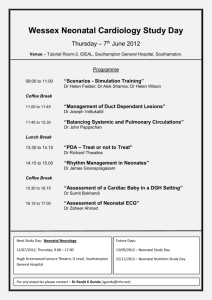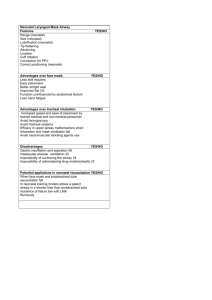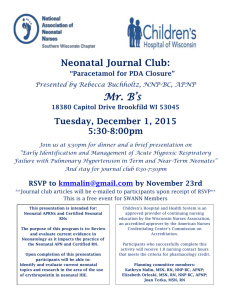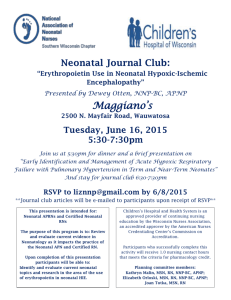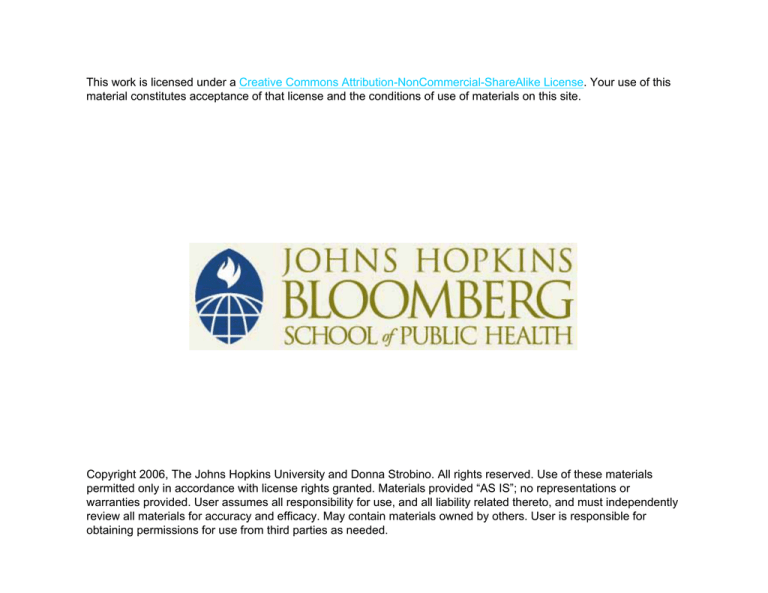
This work is licensed under a Creative Commons Attribution-NonCommercial-ShareAlike License. Your use of this
material constitutes acceptance of that license and the conditions of use of materials on this site.
Copyright 2006, The Johns Hopkins University and Donna Strobino. All rights reserved. Use of these materials
permitted only in accordance with license rights granted. Materials provided “AS IS”; no representations or
warranties provided. User assumes all responsibility for use, and all liability related thereto, and must independently
review all materials for accuracy and efficacy. May contain materials owned by others. User is responsible for
obtaining permissions for use from third parties as needed.
Measures of Neonatal
Morbidity
Donna Strobino, PhD
Bloomberg School of Public Health
Section A
Conventional Measures of Neonatal
Morbidity
Conventional Measures of
Neonatal Morbidity
General broad measures
– LBW: Less than 2,500 grams
– Preterm birth: Less than 37 weeks of
gestation
– Low Apgar score
Reason: Readily available from routine
records/birth certificates
Advantage: Covers large populations
Continued
4
Conventional Measures of
Neonatal Morbidity
Disadvantages
– Do not capture the full range (or degree
of severity) of complications in the
neonate
– Fail to characterize morbidity after the
first few moments of life
– Exclude a large number of infants with
problems in the neonatal period
Continued
5
Conventional Measures of
Neonatal Morbidity
Birth Weight
Excellent agreement of birth weight, as
reported on birth certificates, when
compared with hospital records
Maternal reports of infant’s birth weight are
also highly accurate
– Washington HMO: 91% agreement, only
1% disagree by over 8 oz.
Continued
6
Conventional Measures of
Neonatal Morbidity
Birth Weight
Maternal reports of infant’s birth weight are
also highly accurate
– Two Jerusalem Hospitals: 75% accurate
within 100 gm, only 8% more than 300
gm.
Recall of one’s own birth weight by adult
women is more problematic
Continued
7
Conventional Measures of
Neonatal Morbidity
Low Birth Weight
Selected by Yippo because it was the point
at which the maximum deceleration in the
death rate occurred in relation to birth
weight
Data from Wilcox and Russell show the
relevance of this criterion today (includes
vast majority of births in their residual
distribution)
Continued
8
Conventional Measures of
Neonatal Morbidity
Apgar Score
Developed by anesthesiologist Virginia
Apgar to increase the awareness of
obstetricians and other birth attendants of
the status of the newborn
Measured at one and five minutes (ten
minutes for newborns slow to adjust to
their new environment)
Continued
9
Conventional Measures of
Neonatal Morbidity
Apgar Score
Scores five aspects of newborn’s condition
on a scale of 0–2
– Heart rate (pulse)
– Respiratory effort (respiration)
– Muscle tone (activity)
– Reflex irritability (grimace)
– Color (appearance)
Continued
10
Conventional Measures of
Neonatal Morbidity
Apgar Score
Values for each item are summed to
achieve the total score
General appraisal of scores
– 7–10—Satisfactory
– 4–6—Infant moderately depressed
– 0–3—Infant requires emergency
procedures
Continued
11
Conventional Measures of
Neonatal Morbidity
Apgar Score
Excellent indicator of an infant’s need for
resuscitation and predictor of mortality for
LBW infants
Shown also among term births in Norway
Continued
12
Conventional Measures of
Neonatal Morbidity
Apgar Score
Controversies about Apgar scores
– Apgar scores alone are not evidence of
sufficient hypoxia that results in
neurologic damage
Continued
13
Conventional Measures of
Neonatal Morbidity
Apgar Score
Controversies about Apgar scores
– They are dubious as a measure of
asphyxia
– Scores are difficult to evaluate for preterm infants
Continued
14
Conventional Measures of
Neonatal Morbidity
Apgar Score
Controversies about Apgar scores
– Of questionable predictive value for
sequelae related to neurological or
developmental problems (although a
recent Norwegian study shows a strong
correlation of low Apgar scores with CP
among term births)
15
Infant’s Length of Stay
in the Nursery
Advantages:
Associated with delayed congenital
anomalies, developmental delays and
hospitalization in the first year
Can be easily measured from abstraction of
medical records or from hospital discharge
data
Continued
16
Infant’s Length of Stay
in the Nursery
Disadvantages:
Measured after the fact, so not appropriate
for clinical use (except to identify high risk
infants for follow-up)
Some variation in length of stay due to
institutional differences in health care
practices (primarily related to mean values,
not extremes)
17
Section B
Alternative Measures of Neonatal
Morbidity
Specific Clinical Entities
Respiratory Disease Distress Syndrome
Classification systems available which
utilize signs and symptoms and laboratory
criteria
– For example, severity of RDS measures
use ventilator therapy, blood gas values,
oxygen therapy, and radiological
classification
19
Neurological Examination of the
Newborn (Allen and Capute)
Assessment of the following:
– Posture, extremity and axial tone
– Deep tendon reflexes, pathologic
reflexes, primitive reflexes
– Symmetry, oromotor function, cranial
nerve function, auditory and visual
responses
– Behavior (jitteriness, irritability,
lethargy, consolability)
Continued
20
Neurological Examination of the
Newborn (Allen and Capute)
High correlation with neurological/
developmental outcome at one year
Useful even in extremely pre-term infants
with chronic lung disease and infants with
brain hemorrhage
Relationship to other morbidity is unclear
Summary score is not computed
21
Neonatal Risk Score of Hobel
35 factors arbitrarily selected and scored
by Hobel, et al.
Based on the results of perinatal studies
and personal clinical experience
– Factors generally include a morbid
condition or signs and symptoms of
morbidity
Continued
22
Neonatal Risk Score of Hobel
Each factor is assigned a weight of one,
five, or ten depending on its presumed
value in predicting neonatal mortality
The overall score represents the weighted
sum of the values of each factor present in
the newborn
The weights appear unnecessary; a sum of
the risk factors yield the same results as
the score using the weights
Continued
23
Neonatal Risk Score of Hobel
Self-weighting concept is supported in the
score
The most severe conditions occur in
concert with several other conditions
The score is highly correlated with length
of nursery stay
The score with factors occurring after birth
give higher correlation with length of
nursery stay than score of events
measured at birth
Continued
24
Neonatal Risk Score of Hobel
The score measures morbidity in the
normal weight infant
The relation of the score with subsequent
morbidity is not established
Seldom used, despite evaluation of the
measure
25
Morbidity Assessment Index for
Newborns (MAIN)
Developed as a global measure of
morbidity consisting of clinically relevant
items that can reliably discriminate
between two outcomes across a spectrum
of severity of illness
Focus is to detect clinically important
effects of obstetric intervention
Continued
26
Morbidity Assessment Index for
Newborns (MAIN)
Items included are clinical and laboratory
data that are easily collected from the
usual clinical records
The final inventory includes 47 clinically
relevant pathophysiologic items describing
morbidity at birth, based on 24 attributes
Continued
27
Morbidity Assessment Index for
Newborns (MAIN)
Assessment of the index included
– Evaluation of the “face” or “content”
validity of items
– Construct validation: Item analysis,
internal consistency (dimensionality),
degree items fit into the underlying
construct, item contributed additional
information above and beyond other
items
28
Neonatal Therapeutic Intervention
Scoring System (NTISS)
Assesses severity of illness indirectly
through the therapy given by the physician
rather than through the direct
measurement of physiologic status
Continued
29
Neonatal Therapeutic Intervention
Scoring System (NTISS)
Includes 70 therapies unique to neonatal
intensive care, assigned a weight of one to
four points by an expert panel, based on
therapeutic intensity and complexity
Score can be easily abstracted from
medical records
Provides information beyond traditional
measures such as birth weight
Continued
30
Neonatal Therapeutic Intervention
Scoring System (NTISS)
Directly and strongly related to in-hospital
mortality, length of hospital stay, clinicians’
estimates of mortality risk, and total
hospital charges
But the measure is independent of birth
weight and gestational age
Appears to be problematic for infants who
die within the first few hours of life
31
Score of Neonatal Acute Physiology
Perinatal Extension (SNAP-PE)
An organ system, physiologic-based
severity of illness index developed
specifically for evaluating neonatal
intensive care
Based on objective physiologic
measurements obtained from routine
clinical tests and vital signs
Continued
32
Score of Neonatal Acute Physiology
Perinatal Extension (SNAP-PE)
Contains 34 items that are scored from
zero to five representing the worst
physiologic derangement in the first 24
hours
A major predictor of mortality, which is
independent of birth weight
33
Section C
Measures of Infant Health Status
Measures of Infant Health
Status
Very limited area of development
Hospitalization of the infant: 10-15% in
most samples
Global measures of health status
Four and nine month Pediatric
Complications Scales of Littman and
Parmalee
– A mix of growth, illnesses, anomalies,
deficits, and behavioral problems
Continued
35
Measures of Infant Health
Status
Four and nine month Pediatric
Complications Scales of Littman and
Parmalee
– Show only small correlations with
measure of infant or early childhood
development status
36
Conclusions: Measures of
Neonatal Morbidity
Global measures
– Readily available
– Miss considerable morbidity
More specific measures
– Specific disease focus
– Summary scores
• Used to evaluate OB practice
• Used to evaluate NICU
Continued
37
Conclusions: Measures of
Neonatal Morbidity
More specific measures
– Require access to and use of clinical
records
• Considerable time to obtain data
– Not widely used except for specific
diseases or limited focus of studies
No good measures of infant morbidity
38


